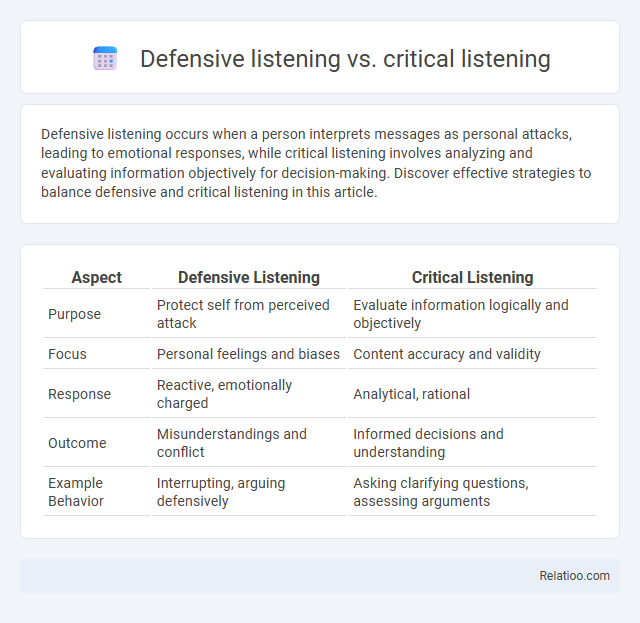Defensive listening occurs when a person interprets messages as personal attacks, leading to emotional responses, while critical listening involves analyzing and evaluating information objectively for decision-making. Discover effective strategies to balance defensive and critical listening in this article.
Table of Comparison
| Aspect | Defensive Listening | Critical Listening |
|---|---|---|
| Purpose | Protect self from perceived attack | Evaluate information logically and objectively |
| Focus | Personal feelings and biases | Content accuracy and validity |
| Response | Reactive, emotionally charged | Analytical, rational |
| Outcome | Misunderstandings and conflict | Informed decisions and understanding |
| Example Behavior | Interrupting, arguing defensively | Asking clarifying questions, assessing arguments |
Understanding Defensive Listening
Defensive listening occurs when you perceive messages as attacks, causing you to react emotionally rather than analytically, which hinders effective communication. Critical listening involves analyzing and evaluating the content objectively to make informed judgments, while defensive listening blocks constructive feedback by misinterpreting intent. Understanding defensive listening helps improve your ability to remain open and receptive, fostering clearer dialogue and reducing misunderstandings.
Defining Critical Listening
Critical listening involves actively analyzing and evaluating the message to form a judgment or make decisions, distinguishing it from defensive listening, which is focused on protecting oneself from perceived attacks, and passive listening, which lacks engagement. It requires attention to the speaker's intent, evidence quality, and logical consistency, making it essential in academic, professional, and decision-making contexts. Mastery of critical listening enhances comprehension, enables effective feedback, and promotes informed responses.
Key Differences Between Defensive and Critical Listening
Defensive listening occurs when a listener perceives comments as personal attacks, triggering emotional responses that hinder understanding, while critical listening involves analyzing and evaluating information objectively to make informed judgments. Key differences between defensive and critical listening include the listener's mindset: defensive listening is driven by insecurity and sensitivity, leading to misinterpretation, whereas critical listening emphasizes open-mindedness and rational assessment of arguments. Effective communication relies on minimizing defensive listening and cultivating critical listening skills to enhance comprehension and decision-making.
Psychological Triggers of Defensive Listening
Defensive listening occurs when psychological triggers such as perceived criticism, threats to self-esteem, or emotional vulnerability cause individuals to interpret messages as attacks, leading to heightened sensitivity and resistance. In contrast, critical listening involves evaluating and analyzing information objectively without emotional bias, while active listening emphasizes understanding and empathy. Recognizing these triggers in defensive listening enhances communication by promoting self-awareness and reducing misinterpretations that hinder constructive dialogue.
The Benefits of Critical Listening in Communication
Critical listening enhances your communication by allowing you to evaluate information objectively, distinguish facts from opinions, and respond thoughtfully, which reduces misunderstandings and improves decision-making. Unlike defensive listening, which triggers emotional reactions, and passive listening, which often leads to missed details, critical listening promotes active engagement and deeper comprehension. Developing this skill sharpens analytical abilities and fosters constructive dialogue in both personal and professional interactions.
Common Signs of Defensive Listening
Common signs of defensive listening include interrupting the speaker, making excuses, or dismissing ideas without fully processing them. Unlike critical listening, which involves evaluating and analyzing the message objectively, defensive listening triggers emotional responses that hinder clear understanding. Recognizing these patterns helps improve communication by fostering openness and reducing misunderstandings.
Essential Skills for Effective Critical Listening
Critical listening involves analyzing and evaluating the message for accuracy and logic, requiring skills such as open-mindedness, attention to detail, and the ability to distinguish fact from opinion. Defensive listening occurs when you perceive a message as a personal attack, leading to biased interpretation and emotional reactions that hinder understanding. Developing essential skills for effective critical listening enables you to filter out defensive responses, actively engage with the speaker's arguments, and respond thoughtfully based on evidence and reasoning.
Impact of Defensive Listening on Relationships
Defensive listening often causes misunderstandings and escalates conflicts by making individuals perceive messages as personal attacks, which harms trust and communication in your relationships. In contrast, critical listening focuses on objectively analyzing and evaluating the content, leading to better problem-solving and informed decisions. Recognizing how defensive listening impacts relational dynamics helps you foster more open and empathetic dialogues.
Strategies to Shift from Defensive to Critical Listening
Shifting from defensive to critical listening involves consciously recognizing emotional triggers and replacing reactive responses with analytical evaluation of the speaker's message. Employing strategies such as pausing before responding, asking clarifying questions, and focusing on understanding the intent behind the information enhances objectivity and reduces misinterpretation. Developing self-awareness and practicing empathy further support the transition, fostering open-mindedness and constructive dialogue.
Cultivating a Healthy Listening Environment
Cultivating a healthy listening environment requires distinguishing between defensive listening, which involves reacting protectively to perceived threats in communication, and critical listening, which emphasizes evaluating and analyzing information objectively for informed decision-making. Encouraging open-mindedness and empathy reduces defensive responses and fosters active engagement, enhancing constructive dialogue. Prioritizing clear, respectful communication transforms defensive listening tendencies into an opportunity for deeper understanding and critical assessment.

Infographic: Defensive listening vs Critical listening
 relatioo.com
relatioo.com